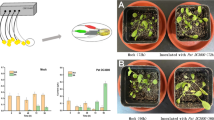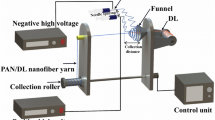Abstract
Using PEDOT as the conductive polymer, an innovative small-scale sensor for directly measuring salicylate ions in plants was developed, which avoided the complicated sample pretreatment of traditional analytical methods and realized the rapid detection of salicylic acid. The results demonstrate that this all-solid-state potentiometric salicylic acid sensor is easy to miniaturize, has a longer lifetime (≥1 month), is more robust, and can be directly used for the detection of salicylate ions in real samples without any additional pretreatment. The developed sensor has a good Nernst slope (63.6 ± 0.7 mV/decade), the linear range is 10−2 ~ 10−6 M, and the detection limit can reach (2.8 × 10−7 M). The selectivity, reproducibility, and stability of the sensor were evaluated. The sensor can perform stable, sensitive, and accurate in situ measurement of salicylic acid in plants, and it is an excellent tool for determining salicylic acid ions in plants in vivo.
Graphical abstract






Similar content being viewed by others
References
Ding P, Ding Y. Stories of salicylic acid: a plant defense hormone. Trends Plant Sci. 2020;25(6):549–65. https://doi.org/10.1016/j.tplants.2020.01.004.
Jayakannan M, Bose J, Babourina O, Rengel Z, Shabala S. Salicylic acid improves salinity tolerance in Arabidopsis by restoring membrane potential and preventing salt-induced K+ loss via a GORK channel. J Exp Bot. 2013;64(8):2255–68. https://doi.org/10.1093/jxb/ert085.
Klessig DF, Tian M, Choi HW. Multiple targets of salicylic acid and its derivatives in plants and animals. Front Immunol. 2016;7:206. https://doi.org/10.3389/fimmu.2016.00206.
Kawano T, Bouteau F. Crosstalk between intracellular and extracellular salicylic acid signaling events leading to long-distance spread of signals. Plant Cell Rep. 2013;32(7):1125–38. https://doi.org/10.1007/s00299-013-1451-0.
Kawano T, Furuichi T, Muto S. Controlled salicylic acid levels and corresponding signaling mechanisms in plants. Plant Biotechnology. 2004;21(5):319–35. https://doi.org/10.5511/plantbiotechnology.21.319.
Sun L, Liu X, Gao L, Lu Y, Li Y, Pan Z, et al. Simultaneous electrochemical determination of indole-3-acetic acid and salicylic acid in pea roots using a multiwalled carbon nanotube modified electrode. Anal Lett. 2015;48(10):1578–92. https://doi.org/10.1007/s00706-019-2375-3.
Rawlinson S, McLister A, Kanyong P, Davis J. Rapid determination of salicylic acid at screen printed electrodes. Microchem J. 2018;137:71–7. https://doi.org/10.1016/j.microc.2017.09.019.
Wang H-R, Bi X-M, Fang Z-J, Yang H, Gu H-Y, Sun L-J, et al. Real time sensing of salicylic acid in infected tomato leaves using carbon tape electrodes modified with handed pencil trace. Sens Actuators B Chem. 2019;286:104–10. https://doi.org/10.1016/j.snb.2019.01.119.
Hu Y, Wang X, Wang C, Hou P, Dong H, Luo B, et al. A multifunctional ratiometric electrochemical sensor for combined determination of indole-3-acetic acid and salicylic acid. RSC Adv. 2020;10(6):3115–21. https://doi.org/10.1039/C9RA09951D.
Ammann D. Ion-selective microelectrodes: principles, design and application: Springer Science & Business Media; 2013. https://doi.org/10.1007/978-3-642-52507-0.
Karimi-Maleh H, Orooji Y, Karimi F, Alizadeh M, Baghayeri M, Rouhi J, et al. A critical review on the use of potentiometric based biosensors for biomarkers detection. Biosens Bioelectron. 2021;184:113252. https://doi.org/10.1016/j.bios.2021.113252.
Mazloum-Ardakani M, Pourhakkak P, Salavati-Niasari M, Karimi M, Mashhadizadeh M. Highly selective and sensitive membrane salicylate electrode based on complex of (1, 8-diamino-3, 6-dioxaoctane) nickel (II). J Braz Chem Soc. 2011;22(1):30–7. https://doi.org/10.1590/S0103-50532011000100004.
Nur Ayanoğlu M, Kormalı Ertürün HE, Demirel Özel A, Şahin Ö, Yılmaz M, Kılıç E. Salicylate ion-selective electrode based on a calix [4] arene as ionophore. Electroanalysis. 2015;27(7):1676–84. https://doi.org/10.1002/elan.201400737.
Shao Y, Ying Y, Ping J. Recent advances in solid-contact ion-selective electrodes: functional materials, transduction mechanisms, and development trends. Chem Soc Rev. 2020;49(13):4405–65. https://doi.org/10.1039/C9CS00587K.
Shokrollahi A, Abbaspour A, Ghaedi M, Haghighi AN, Kianfar A, Ranjbar M. Construction of a new Cu2+ coated wire ion selective electrode based on 2-((2-(2-(2-(2-hydroxy-5-methoxybenzylidene amino) phenyl) disufanyl) phenylimino) methyl)-4-methoxyphenol Schiff base. Talanta. 2011;84(1):34–41. https://doi.org/10.1016/j.talanta.2010.12.002.
Firooz A, Mazloum M, Safari J, Amini M. Coated-wire copper(II)-selective electrode based on phenylglyoxal-α-monoxime ionophore. Anal Bioanal Chem. 2002;372(5):718–22. https://doi.org/10.1007/s00216-001-1205-7.
Hu J, Stein A, Bühlmann P. Rational design of all-solid-state ion-selective electrodes and reference electrodes. TrAC Trends Anal Chem. 2016;76:102–14. https://doi.org/10.1016/j.trac.2015.11.004.
Bahro C, Goswami S, Gernhart S, Koley D. Calibration-free solid-state ion-selective electrode based on a polarized PEDOT/PEDOT-S-doped copolymer as back contact. Anal Chem. 2022. https://doi.org/10.1021/acs.analchem.2c00748.
Gao N, Yu J, Tian Q, Shi J, Zhang M, Chen S, et al. Application of PEDOT: PSS and its composites in electrochemical and electronic chemosensors. Chemosensors. 2021;9(4):79. https://doi.org/10.3390/chemosensors9040079.
Huang M-R, Li X-G, Li F-R. Highly sensing and transducing materials for potentiometric ion sensors with versatile applicability. Prog Mater Sci. 2021:100885. https://doi.org/10.1016/j.pmatsci.2021.100885.
Huang S-F, Shih W-L, Chen Y-Y, Wu Y-M, Chen L-C. Ion composition profiling and pattern recognition of vegetable sap using a solid-contact ion-selective electrode array. Biosens Bioelectron: X. 2021;9:100088. https://doi.org/10.1016/j.biosx.2021.100088.
Casado N, Mecerreyes D. Introduction to redox polymers: classification, characterization methods and main applications. 2020. https://doi.org/10.1039/9781788019743-00001.
Elgrishi N, Rountree KJ, McCarthy BD, Rountree ES, Eisenhart TT, Dempsey JL. A practical beginner’s guide to cyclic voltammetry. J Chem Educ. 2018;95(2):197–206. https://doi.org/10.1021/acs.jchemed.7b00361.
Benoudjit A, Bader MM, Salim WWAW. Study of electropolymerized PEDOT: PSS transducers for application as electrochemical sensors in aqueous media. Sens Bio-Sens Res. 2018;17:18–24. https://doi.org/10.1016/j.sbsr.2018.01.001.
Zhou C, Liu Z, Du X, Ringer SP. Electrodeposited PEDOT films on ITO with a flower-like hierarchical structure. Synth Met. 2010;160(15–16):1636–41. https://doi.org/10.1016/j.synthmet.2010.05.033.
Zhao G, Liang R, Wang F, Ding J, Qin W. An all-solid-state potentiometric microelectrode for detection of copper in coastal sediment pore water. Sens Actuators B Chem. 2019;279:369–73. https://doi.org/10.1016/j.snb.2018.09.125.
Volkov AV, Wijeratne K, Mitraka E, Ail U, Zhao D, Tybrandt K, et al. Understanding the capacitance of PEDOT: PSS. Adv Func Mater. 2017;27(28):1700329. https://doi.org/10.1002/adfm.201700329.
Johnson RD, Bachas LG. Ionophore-based ion-selective potentiometric and optical sensors. Anal Bioanal Chem. 2003;376(3):328–41. https://doi.org/10.1007/s00216-003-1931-0.pdf.
Starikova T, Shumilova G, Valiotti A. Electrochemical characteristics of membranes based on Mn (III) tetraphenylporphyrin. Russ J Electrochem. 2013;49(9):856–62. https://doi.org/10.1134/S1023193513090115.
Qin Y, Bakker E. Elimination of dimer formation in InIIIporphyrin-based anion-selective membranes by covalent attachment of the ionophore. Anal Chem. 2004;76(15):4379–86. https://doi.org/10.1021/ac049577f.
Lisak G, Tamaki T, Ogawa T. Dualism of sensitivity and selectivity of porphyrin dimers in electroanalysis. Anal Chem. 2017;89(7):3943–51. https://doi.org/10.1021/ac049577f.
Maruri-López I, Aviles-Baltazar NY, Buchala A, Serrano M. Intra and extracellular journey of the phytohormone salicylic acid. Front Plant Sci. 2019:423. https://doi.org/10.3389/fpls.2019.00423
Szigeti Z, Vigassy T, Bakker E, Pretsch E. Approaches to improving the lower detection limit of polymeric membrane ion‐selective electrodes. Electroanalysis: An International Journal Devoted to Fundamental and Practical Aspects of Electroanalysis. 2006;18(13‐14):1254–65. https://doi.org/10.1002/elan.200603539.
Yrjänä V, Saar I, Ilisson M, Kadam SA, Leito I, Bobacka J. Potentiometric carboxylate sensors based on carbazole-derived acyclic and macrocyclic ionophores. Chemosensors. 2020;9(1):4. https://doi.org/10.3390/chemosensors9010004.
Lisak G. Reliable environmental trace heavy metal analysis with potentiometric ion sensors-reality or a distant dream. Enviro Pollut. 2021;289:117882. https://doi.org/10.1016/j.envpol.2021.117882.
Farhadi K, Maleki R, Hosseinzadeh Yamchi R, Sharghi H, Shamsipur M. [Tetrakis(4-<i>N</i>, <i>N</i>-dimethylaminobenzene)porphyrinato]manganese(III) acetate as a novel carrier for a selective iodide PVC membrane electrode. Anal Sci. 2004;20(5):805–9. https://doi.org/10.2116/analsci.20.805.
Geilfus C-M. The pH of the apoplast: dynamic factor with functional impact under stress. Mol Plant. 2017;10(11):1371–86. https://doi.org/10.1016/j.molp.2017.09.018.
Abakumova R, Valiotti A, Vasil’eva O, Kopylova E, Shumilova G, Mikhel’son K. pH sensitivity of a porphyrin film electrode. Russ J Gen Chem. 2003;73(2):300–7. https://doi.org/10.1023/A:1024764726797.
Pingarrón JM, Labuda J, Barek J, Brett CM, Camões MF, Fojta M, et al. Terminology of electrochemical methods of analysis (IUPAC Recommendations 2019). Pure Appl Chem. 2020;92(4):641–94. https://doi.org/10.1515/pac-2018-0109.
He C, Wang Z, Wang Y, Hu R, Li G. Nonenzymatic all-solid-state coated wire electrode for acetylcholine determination in vitro. Biosens Bioelectron. 2016;85:679–83. https://doi.org/10.1016/j.bios.2016.05.077.
Paolesse R, Nardis S, Monti D, Stefanelli M, Di Natale C. Porphyrinoids for chemical sensor applications. Chem Rev. 2017;117(4):2517–83. https://doi.org/10.1021/acs.chemrev.6b00361.
Orazem ME, Tribollet B. Electrochemical impedance spectroscopy. New Jersey. 2008:383–9. https://doi.org/10.1038/s43586-021-00039-w.
Anderson EL, Bühlmann P. Electrochemical impedance spectroscopy of ion-selective membranes: artifacts in two-, three-, and four-electrode measurements. Anal Chem. 2016;88(19):9738–45. https://doi.org/10.1021/acs.analchem.6b02641.
Radecka H, Grzybowska I, Radecki J, Jakubowski P, Loteran S, Orlewska C, et al. Salicylate determination in human plasma by ISEs incorporating Mn (III)-porphyrine and Zn (II)-dipyrromethene. Anal Lett. 2007;40(2):387–401. https://doi.org/10.1080/00032710600964767.
Chai Y, Jiang F, Yuan R, Xu L, Xu W. A highly selective salicylate electrode based on Schiff base complexes of cobalt(III). Anal Lett. 2003;36(11):2379–92. https://doi.org/10.1081/AL-120024329.
Luo EP, Chai YQ, Yuan R, Dai JY, Xu L. Highly salicylate-selective membrane electrode based on a new thiomacrocyclic Schiff base complex of binuclear copper(II) as neutral carrier. Desalination. 2009;249(2):615–20. https://doi.org/10.1016/j.desal.2008.12.054.
Ardakani MM, Pourhakkak P, Salavati-Niasari M. Potentiometric coated wire electrode for salicylate based on zinc(II) acetylacetonate. J Braz Chem Soc. 2007;18(4):782–8. https://doi.org/10.1590/S0103-50532007000400017.
Firooz AliR, Amini MK, Tangestaninejad S, Shahrokhian S. Vanadyl and molybdenyl phthalocyanines as ionophores for salicylate-selective membranes coated on graphite electrodes. Anal Lett. 2001;34(5):661–74. https://doi.org/10.1081/AL-100103210.
Xu W, Yuan R, Chai Y. Salicylate-selective potential response of an electrode based on a copper(II)-phthalocyanine derivative as an ionophore. Chin J Chem. 2009;27(1):99–104. https://doi.org/10.1002/cjoc.200990033.
Funding
This work was supported by National Key Research and Development Program of China (No.2022YFD2002301). The project was supported by the National Natural Science Foundation of China (Grant No. 61571443).
Author information
Authors and Affiliations
Corresponding author
Ethics declarations
Conflict of interest
The authors declare no competing interests.
Additional information
Publisher's note
Springer Nature remains neutral with regard to jurisdictional claims in published maps and institutional affiliations.
Supplementary Information
Below is the link to the electronic supplementary material.
Rights and permissions
Springer Nature or its licensor (e.g. a society or other partner) holds exclusive rights to this article under a publishing agreement with the author(s) or other rightsholder(s); author self-archiving of the accepted manuscript version of this article is solely governed by the terms of such publishing agreement and applicable law.
About this article
Cite this article
Fan, CX., Li, JH., Yao, JP. et al. All-solid-state potentiometric salicylic acid sensor for in-situ measurement of plant. Anal Bioanal Chem 415, 1979–1989 (2023). https://doi.org/10.1007/s00216-023-04616-8
Received:
Revised:
Accepted:
Published:
Issue Date:
DOI: https://doi.org/10.1007/s00216-023-04616-8




